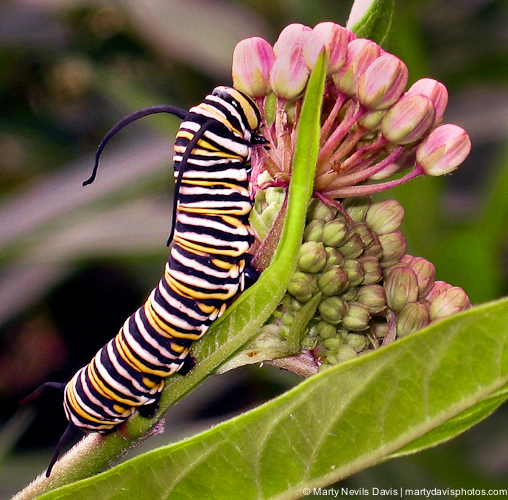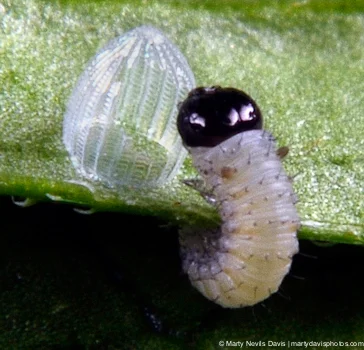monarch butterfly larva / caterpillar
Monarch larva or larvae (plural) is also called a caterpillar (or cat for short). They increase in weight about 3,000 times from when they chew their way our of their egg until they’re about the size seen here on the left, approximately two inches long. It’s hard to imagine that anything could grow that much in a mere two weeks, or ever. (As an example of how amazing that is, if you took an 8 lb. baby and it increased in size 3,000 times in two weeks, it would weigh 12 tons, or the size of two adult male elephants!) These little guys start out about 1/16th of an inch long and eat only milkweed almost non-stop except to shed their skins five times (called instars), with the last shedding opening up their world to an amazing new journey into the third stage of metamorphosis, the pupa, also know as a chrysalis.
The body of a Monarch larva is divided into three sections, the head, thorax, and abdomen. They have sixteen legs; the front six are a part of the thorax and are are "true" legs; these will develop into the butterfly's legs. The remaining ten legs are called "prolegs." They have twelve simple eyes but can only really see light and dark and movement.
As you can see in the photo on the right, baby monarchs don't start life with the white, black, and yellow stripes that we're used to seeing. It's not until they shed their skin that we begin to see their bright colors. The baby butterfly in this photo has just hatched out of his egg and he's in the process of eating the shell, his first meal.
The caterpillar's body is covered by an exoskeleton which it will shed five times, with each new one being larger than the one before. (They even shed their faces!) This is called molting and the five stages are instars. The last molt is the beginning of it's journey as it becomes a pupa, or chrysalis. If you're raising monarchs it's important to not disturb your caterpillar during their molting between instars. They will sit still for long time (a number of hours), and when ready they will shed its skin (exoskeleton), then turn and eat it, just as it does it's eggshell.
Monarch caterpillars have twelve simple eyes and can't see much. Maybe light and dark. The monarch butterfly has two complex eyes and can see more colors of the rainbow than we can.
The front and rear sets of black tentacles are often confused with antenna. The antenna are actually very small and are located on either side of it's mouth. Note that butterflies, including baby butterfly caterpillars, taste with their feet to see what's edible, and they smell with their antenna. They have very strong jaws for chewing milkweed (without getting gummed-up with the white sticky latex inside milkweed), and it plows through it like an eating machine. A unique organ also located by its mouth is called a spinneret, which the caterpillar uses to spin silk. If you notice a caterpillar when it walks, it moves its head from side to side; it's really putting down silk wherever it goes, which allows it to crawl on any surface. It also creates a great deal of silk when forming its silk button before shedding its last skin to create the chrysalis.
caterpillars of all sizes
In the photo below you can see multiple sizes of Monarch caterpillars. From the time a tiny caterpillar hatches (ecloses) from it's egg, until it sheds its fifth, and last skin to form a chrysalis, these baby butterflies will increase in size 3,000 times in just a couple of weeks. They eat almost non-stop except when they're molting.
what is O.E.?
If you've raised Monarchs for awhile, you're probably heard of O.e. It's a common protozoan parasite Ophryocystis elektroscirrha, which infects monarch butterflies (Danaus plexippus) in natural populations. This parasite infects monarch butterflies at the larval stage, when caterpillars ingest parasite spores that are deposited by adult butterflies on the milkweed plants that these caterpillars eat. Parasites replicate to high numbers in the monarch caterpillar, such that adult butterflies can carry millions of parasite spores. The transmission of spores occurs from egg-laying adult butterflies to their offspring caterpillars. For more info about O.e., please visit this page.
other resources
"7 Common Monarch Diseases, Parasites, and Caterpillar Killers" (Monarch Butterfly Garden)
when a caterpillar is poisoned
It's only been in the last several of years that I've encountered caterpillars becoming poisoned by chemicals in or on milkweed. If a caterpillar has been poisoned, they'll quit eating, become lethargic, and begin vomiting a lime-green liquid all over. (A caterpillar's blood is also lime-green but will turn black in ten minutes.) If not given safe milkweed immediately, they will die. Sometimes they'll die anyway, depending upon their size and how much of the poisoned milkweed they've ingested. It's important to always wash your milkweed and allow it to dry before feeding it to your caterpillars. There are also chemicals called neonicotinoids, or neonics, which are systemic, can't be washed off, and will certainly kill caterpillars. Please see my milkweed page for a lot more information.




